- Key targets of Singapore’s Green Plan include planting 1 million more trees, quadrupling solar energy deployment, reducing the waste sent to landfill by 30%, a least 20% of schools to be carbon neutral, and all newly registered cars cleaner-energy models from 2030.
- In South Korea, Digital and green are going hand in hand. The nation believes that the green remodeling of the economy can only be enabled by digital innovation, as seen in the key 10 projects, such as Digital Twins, New Mobility Systems, AI Government, and so on.
Worldwide, many countries have passed stimulus packages to address the compounding risks of COVID-19 and climate change, promoting “Build Back Better” initiatives.
The European Union has passed the European Green Deal and strives to be the first climate-neutral continent in 2050. In the US, the new Biden administration has dedicated around US$2 trillion to invest in clean energy, infrastructure, and mobility and is preparing to deal with climate change in a way no US president has done before. China has unveiled a US$1.4 trillion “New Infrastructure” plan to speed up its industrial revolution and support its sustainability efforts. The extension of inter-city high-speed connections is one of the major highlights of the Chinese plan.
Where is Asia-Pacific standing in the current rush towards greening economies? Many commentators have lamented over the fact that the region is not reaching enough for the environment reset button, as argued in this report from ING (see graph below).
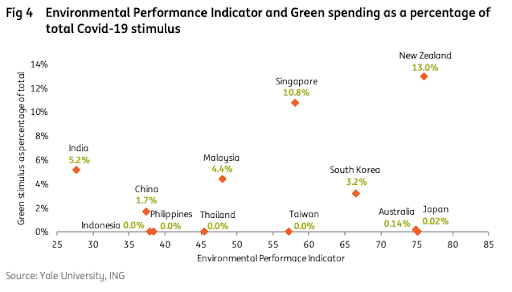
Interesting policy innovations and green recovery plans in Singapore and South Korea are worth exploring.
Singapore: Whole-of-Nation Efforts to Fight Climate Change
On February 10th 2021, Singapore publicly announced its Green Plan 2030, an ambitious “whole-of-nation” effort to accelerate the city-state’s sustainability agenda.
Key targets of Singapore’s Green Plan include:
- Planting 1 million more trees
- Quadrupling solar energy deployment by 2025
- Reducing the waste sent to landfill by 30% by 2030
- At least 20% of schools to be carbon neutral by 2030
- All newly registered cars to be cleaner-energy models from 2030
Singapore’s Green Plan 2030 offers interesting insights to prepare for a green future, for two main reasons:
- It is a city-scale green recovery plan and thus gives a vision of how cities could adapt to a climate-resilient future.
Singapore is a city-state and is able to orient its energy, mobility, water and food policies. It’s a unique situation in the sense that other cities might not have the same capacity to fully govern and influence their energy, food or water supply chains, leaving less room for manoeuvre.
- It has a clear emphasis on climate change, particularly sea-level rise, and translates new planning concepts into policies.
As one of the greenest cities in the world, Singapore can leverage its green (and blue) assets to foreground new planning responses to climate change and environmental crises, such as the City in Nature approach where biodiversity flourishes side by side with humans, thanks to world-class nature parks and interconnected urban gardens.
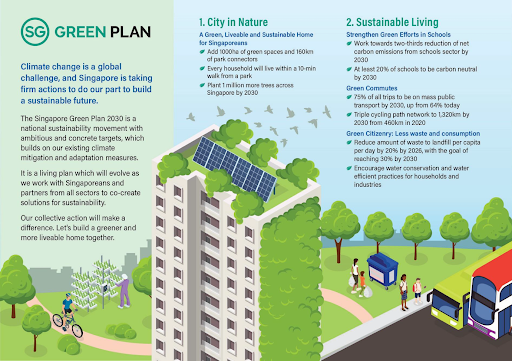
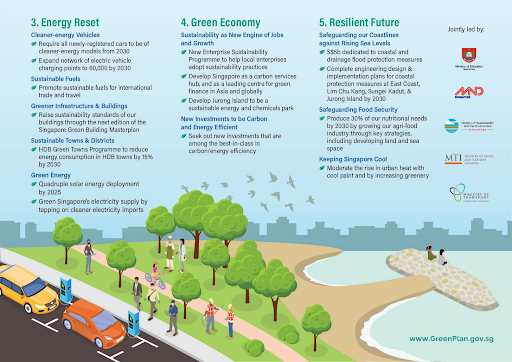
South Korea: a Digital and Green Society New Deal
South Korea is one of the biggest polluters per capita in Asia-Pacific.
The Korean New Deal, announced in July 2020, plans to invest US$135 billion on two main schemes – the Digital New Deal and the Green New Deal– together with overarching policy support to strengthen employment and the social safety net.

Source: Korean New Deal, Ministry of Economy and Finance
The Green New Deal means investing in advanced technology initiatives to create jobs and includes:
- An expansion of solar panels and wind turbines to 42.7 gigawatts by 2025
- An acceleration of smart grids and plans to install smart meters in 5 million more apartments, to help consumers reduce their electricity use
- Investments in “microgrid communities”, using renewable energy and energy storage systems in regional areas, to create decentralised, low-carbon energy systems
- A target of 1.13 million electric vehicles and 200,000 hydrogen-powered fuel-cell electric vehicles on Korean roads by 2025
- Circular economy initiatives such as reducing and recycling energy, using advanced computerised power grids in factories
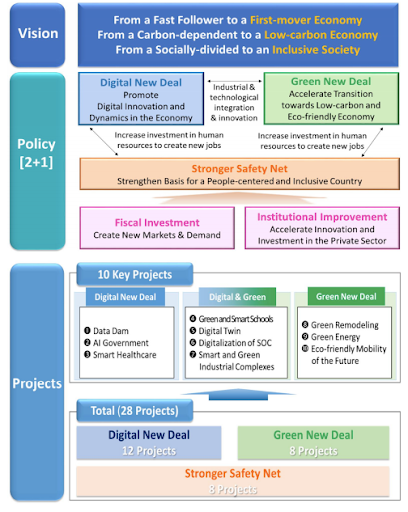
Source: Korean New Deal, Ministry of Economy and Finance
The “K-New Deal” is ambitious and unique and while it seems to be more “grey” than green, there are interesting features to bear in mind:
- Digital and Green are going hand in hand
South Korea envisions strong synergies between industrial and technological innovations in the digital and green sectors, not surprising for such a tech-savvy country. The green remodeling of the economy can only be enabled by digital innovation, as seen in the key 10 projects, such as Digital Twins, New Mobility Systems, AI Government, and so on.
- The creation of a “Data Dam” to build up the foundations of the future economy
The K-New Deal responds to global data usability challenges by creating a “data dam” infrastructure to collect data from public and private sources and then standardize it so it can be analyzed. How much this ambitious initiative will support the greening of the economy remains to be seen but South Korea, more than ever, bets on high-tech solutions for its environmental and social challenges.
Green recovery plans are laying the foundations of our future societies and economies, through targeted investments, policy innovations, new regulations, and financial priorities. It’s in cities that green plan investments will materialize, and it’s in cities that new technologies and solutions will have their deepest impacts.
Globally, government efforts in terms of climate action and the consequences for the design, planning, and management of our urban environments are a good start but might not be sufficient to really halt climate change. It is important to watch this space and monitor how countries, in the Asia Pacific and globally, will implement their climate action plans.
According to a recent U.N. analysis, pledges made so far by countries around the globe to cut greenhouse gas emissions fall strikingly short of the profound changes necessary to avoid the most catastrophic impacts of climate change.
An earlier version of this article was published on the Cities in Mind platform in March 2020.


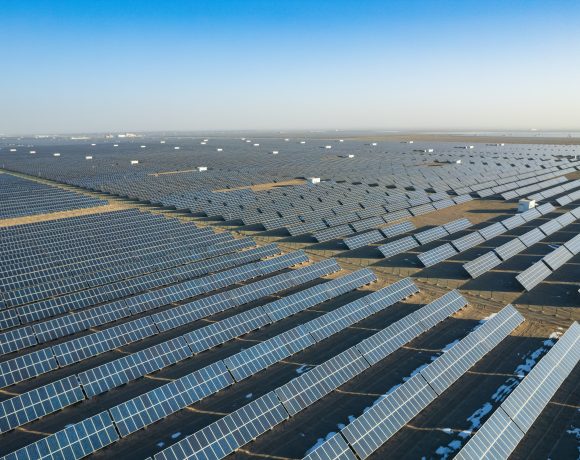
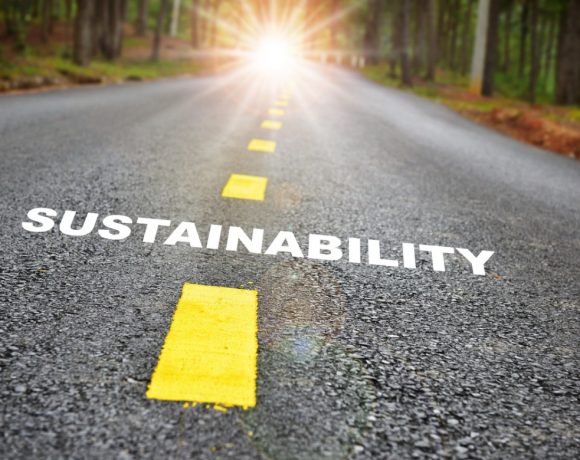
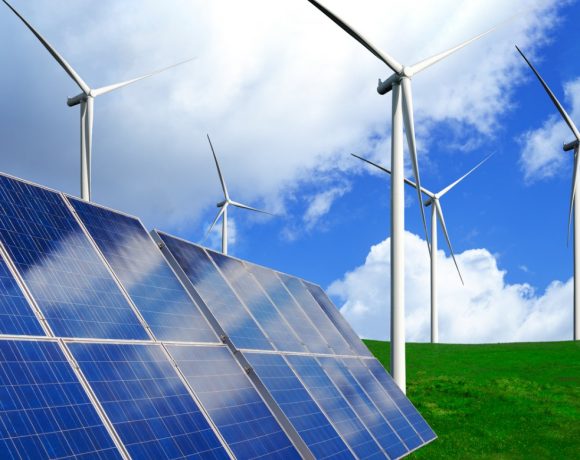

NO COMMENT